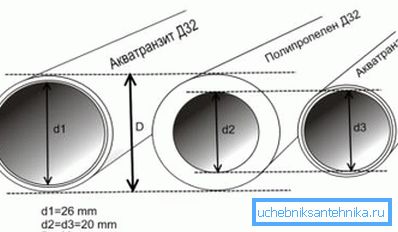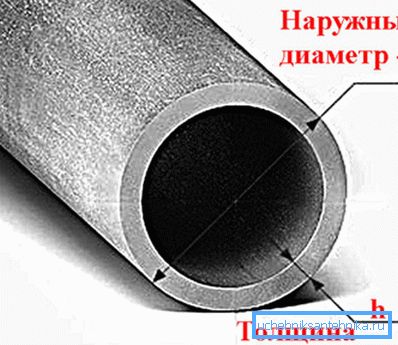Conditional pipe pass - features of this parameter
The nominal pipe pass is a nominal parameter reflecting the capacity of the system, which is a guideline in the design and installation, as it is necessary to select pipes and fittings that are ideally suited to each other. It is worth noting that this indicator means the averaged value, as it is always rounded up or down so that the obtained value meets the standards reflected in the norms of GOST.

Basic system parameters
When characterizing certain communications, not only the conditional passage is used, this indicator is not enough, as more often it does not exactly correspond to the actual dimensions. There are several values that can be taken into account in the design and installation work:
| Nominal diameter | In fact, this is the same as the conditional passage, the value is always approximated and most often it does not coincide with the actual figures. The common designation is the abbreviation "Du", it is for it can be guided by the features of a particular system. Indeed, in the project documentation often there is only this parameter, and the choice of a specific variant of pipes and fittings depends on the features of the object. |
| Outside diameter | This is an accurate indicator that reflects the true size of the pipe outside and may differ significantly from DN, especially when using thick-walled PVC pipes or aluminum. This factor should be taken into account in order to place communications in certain spaces and when choosing insulation with a shallow depth |
| Inner diameter | In fact, it is this figure that best reflects the capacity of a pipeline. It is very simple to calculate the size of the internal cavity: the wall thickness is taken away from the outer diameter, as a last resort, you can use a caliper - this will determine the parameter very quickly and accurately |

Calculus techniques and important nuances
We figured out what a conditional passage is, it is now necessary to consider the topic in more detail and in detail.
Note! All necessary information reflecting such important indicators as the throughput of pipelines, connecting nodes and fittings, as well as the necessary characteristics of sanitary systems and equipment connected to pipes, are reflected in GOST 28338-89. It is this regulatory act that is the main document that guides all construction and design organizations.
Measurement systems

On the market you can find products, the physical dimensions of which are denoted differently:
- If you purchase metal pipes for gas pipelines and water-supplying communications, then most likely their indicators will be indicated in inches.. This is a generally accepted measurement system, which is used by both specialists and sales organizations. If the whole system consists of metal, then there will be no problems, as the fittings have an inch marking.
- Products made of PVC, polyethylene, polypropylene, metal-plastic and other types of polymeric materials are marked differently, all their indicators are denoted in millimeters. It is important to choose the right diameter of the pipe - the conditional passage should be sufficient to ensure uninterrupted supply of this or that substance or sewer drainage. It is best to seek the advice of qualified professionals, this will help to avoid mistakes.
Note! Very often questions arise when it is necessary to connect metal and plastic pipes, since the size of some is indicated by inches, and the second - by millimeters. To simplify this procedure, you can use the table below. So you can easily figure out what products to acquire, in order to comply with all the parameters of communication.

The value of the indicator

The definition of the conditional passage of pipes is very important if you do all the work with your own hands:
- First, system performance indicators largely depend on the diameter. If the sewage pipe is too narrow, it will constantly overflow, which can lead to the rapid formation of blockages and even penetration of sewage into the room through plumbing fixtures, which is very undesirable. With a small pipe size, the house will not be provided with high-quality water, and in the case of heating, it may turn out that the parameters are too low.
- Secondly, depending on the size, the price also varies considerably. Using too large diameters is often impractical and even costly (for example, in the heating system the volume of heat carrier increases significantly and much more energy is used to heat it).
If the project has already been developed, it is better to make sure once again that this is correct and complies with the standards; for this, it is better to contact specialists, since no instruction will tell you about the problems that may be encountered during the operation of communications.

Conclusion
Correctly calculating the indicator Dy means to ensure uninterrupted operation of the pipeline and reduce the likelihood of failures and breakdowns. The video in this article will tell you some important facts regarding the subject under consideration.